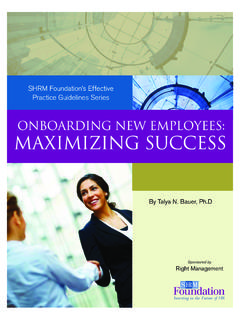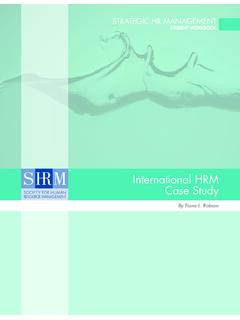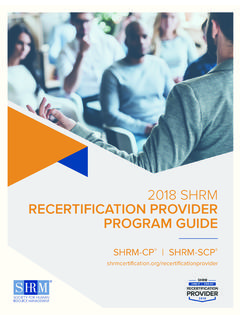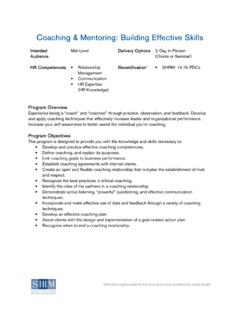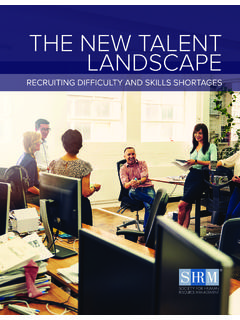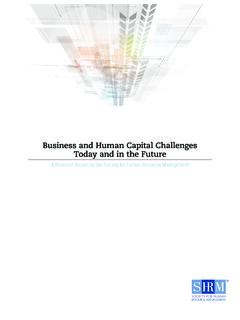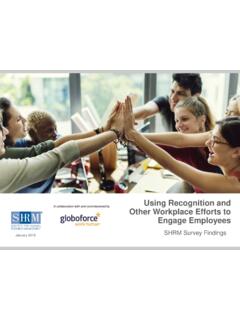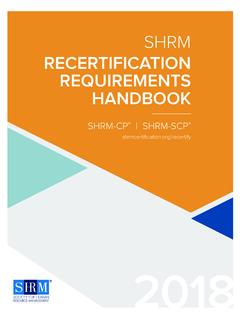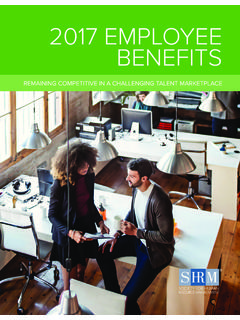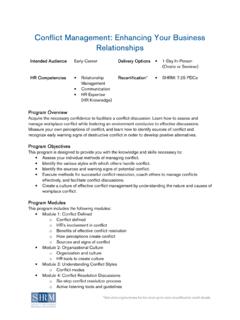Transcription of 2016 Human Capital Report - shrm.org
1 2016 Human CapitalBenchmarking ReportNovember 2016 shrm Benchmarking Service The data in this Report can be customized for your organization by industry, staff size, geographic or metropolitan region, profit status (for profit/nonprofit), sector (public/private), unionized environments, and more. The data in this Report were collected from the 2016 shrm Human Capital Benchmarking Survey. Additional reports available in Health Care, Paid Leave, Employee Benefits Prevalence, and Talent view sample reports or place an order, visit call (703) 535-63662 Human Capital Benchmarking Report shrm 2016 Are you looking for data that is customizable by industry, region, organization staff size, and more? shrm s Benchmarking Service provides just SHRMF ounded in 1948, the Society for Human Resource Management ( shrm ) is the world s largest HR membership organization devoted to Human resource management. Representing more than 275,000 members in over 160 countries, the Society is the leading provider of resources to serve the needs of HR professionals and advance the professional practice of Human resource management.
2 shrm has more than 575 affiliated chapters within the United States and subsidiary offices in China, India and United Arab Emirates. Visit us at of ContentsKey Findings4 Statistical Definitions5 Human Capital Benchmarking Survey Findings6 Demographics19 Methodology28 Human Capital Benchmarking Report shrm 20163 Key Findings Tuition:61 percent of employers offered tuition reimbursement. The average maximum reimbursement allowed for tuition/education expenses per year was approximately $4,000. Compensation:The average annual salary increase was percent each year. The average target bonus percentage for nonexecutives was percent compared to percent for executives. Retirement:Among those companies that offered a 401(k), 402(b) or similar plan (92 percent), an average of 66 percent of employees participated. The average maximum employer match was 6 percent. Succession Planning:One-third of companies (34 percent) had a succession plan. The positions most commonly included in an organization s succession plan included the executive team (76 percent), senior management (71 percent) and middle management (46 percent).
3 Management Responsibility:Those employees in middle management positions had the most direct reports (a median of 8 direct reports) compared to those at the executive level (a median of 5 direct reports).4 Human Capital Benchmarking Report shrm 2016 The average maximum employer match for a 401(k) or similar plan was 6%.Statistical Definitions5 n The letter n in tables and figures indicates the number of respondents to each question. In other words, when it is noted that n = 25, it indicates that the number of respondents was percentile is the percentage of responses in a group that have values less than or equal to that particular value. For example, when data are arranged from lowest to highest, the 25th percentile is the point at which 75% of the data are above it and 25% are below it. Conversely, the 75th percentile is the point at which 25% of the data are above it and 75% are below (50th percentile)The median is the midpoint of the set of numbers or values arranged in ascending order.
4 It is recommended that the median is used as a basis for all interpretations of the data when the average and median are discrepant. AverageThe average is the sum of the responses divided by the total number of responses. It is also known as the mean. This measure is affected more than the median by the occurrence of outliers (extreme values). For this reason, the average reported may be greater than the 75th percentile or less than the 25th Capital Benchmarking Report shrm 2016 Revenue per FTE is the total amount of revenue received during an organization s fiscal year divided by the number of income before taxes per FTE is the net income before taxes divided by the number of FTEsn25th PercentileMedian75th PercentileAverageRevenue per FTE739$65,502$143,396$271,450$335,594 Net income before taxes per FTE579$0$9,980$61,882$57,815n= 2, Capital Benchmarking Report shrm 2016 Organizational DataUse of Succession Plans by Organizations7 Human Capital Benchmarking Report shrm 201634%66%HaveNot haven= 1,503.
5 Respondents who answered Not sure were excluded from this Included Within the Organization s Succession Plan76%71%46%25%12%Executive teamSenior managementMiddle managementIndividual contributor:professionalIndividual contributor:nonprofessionaln= Capital Benchmarking Report shrm 2016 Span of Control Data9 Human Capital Benchmarking Report shrm 2016n25th PercentileMedian75th PercentileAverageExecutive level1,0044 direct reports5 direct reports8 direct reports7 direct reportsMiddle management1,0144 direct reports8 direct reports14 direct reports11 direct reportsNonmanagement/individual contributors9290 direct reports0 direct reports2 direct reports3 direct reportsNonexempt (hourly) nonmanagement9140 direct reports0 direct reports0 direct reports2 direct reportsHR Department Data10 Human Capital Benchmarking Report shrm 2016n25th PercentileMedian75th PercentileAverageHR-to-employee ratio1, of HR staff in supervisory roles1,75633%50%100%56%Percentage of HR staff in professional/technical roles1,3900%36%57%38%Percentage of HR staff in administrative support roles1,4690%25%50%28%Reporting Structure for the Head of HRn= 1,993.
6 CEO = Chief executive officer. COO = Chief operation officer. CFO = Chief financial officer. CAO = Head of administration/chief administration Capital Benchmarking Report shrm 201636%19%10%5%13%4%12%HR Expense Data12 Human Capital Benchmarking Report shrm 2016n25thPercentileMedian75thPercentileA verageHR-expense-to-operating expense $659$1,667$6,000$10,211 Compensation Data13 Human Capital Benchmarking Report shrm 2016n25th PercentileMedian75th PercentileAverageAnnual salary increase1, as a percentage of operating bonus percentage for bonus percentage for that Offer Tuition Reimbursement for Employees62%38%OfferedNot offeredn= 1,587. Respondents who answered Not sure were excluded from this Capital Benchmarking Report shrm 2016 Tuition/Education Data15 Human Capital Benchmarking Report shrm 2016n25th PercentileMedian75th PercentileAverageMaximum reimbursement allowed for tuition/ education expenses per year763$1,500$3,000$5,250$3,998 Percentage of employees participating in tuition/education reimbursement programs7291%2%6%7%Employment Data16 Human Capital Benchmarking Report shrm 2016n25th PercentileMedian75th PercentileAverageTime-to-fill1,19220 days30 days47 days42 daysCost-per-hire864$500$2,000$4,500$4,1 29 Average employee tenure1,4074 years7 years11 years8 yearsAnnual overall turnover rate1,1596%15%25%19%Annual voluntary turnover rate9343%9%16%12%Annual involuntary turnover rate9121%3%8%6%Retirement Data17 Human Capital Benchmarking Report shrm 2016nOfferedNot Offered401(k), 403(b)
7 Or similar plan1,58692%7%Percentage of organizations providing employer contribution1,34884%14%Percentage of organizations with automatic employee enrollment1,01862%38%Retirement Data18 Human Capital Benchmarking Report shrm 2016n25th PercentileMedian75th PercentileAverageEmployee participation rate1,05445%75%90%66%Percentage of an employee s contribution matched by the employer66650%50%100%66%Maximum percentage of salary matched by the employer9723%5%6%6%Demographics: Organization Industry19 PercentageServices Professional, Scientific, Technical27%High-Tech23%Retail/Wholesale Trade22%Consulting21%Health Care, Social Assistance20%Manufacturing (durable goods)17%Manufacturing (non-durable goods)15%Business Support Services 12% Human Capital Benchmarking Report shrm 2016 Note: n= 2,044. Percentages do not total 100% due to multiple response : Organization Industry20 PercentageFinance12%Educational Services11%Government/Public Administration State/Local11%Construction, Mining, Oil & Gas10%Publishing, Broadcasting, Other Media10%Transportation, Warehousing7%Religious, Grant-Making, Civic, Professional, and Similar Organizations7% Human Capital Benchmarking Report shrm 2016 Note: n= 2,044.
8 Percentages do not total 100% due to multiple response : Organization Industry21 PercentageTelecommunications5%Insurance5 %Repair and Maintenance5%Services Accommodation, Food & Drinking Places5%Utilities4%Real Estate, Rental, Leasing4%Arts, Entertainment, Recreation3%Biotech 3% Human Capital Benchmarking Report shrm 2016 Note: n= 2,044. Percentages do not total 100% due to multiple response : Organization Industry22 PercentagePharmaceutical2%Association Professional/Trade 2%Waste Management & Remediation Services 2%Government/Public Administration Federal1% Human Capital Benchmarking Report shrm 2016 Note: n= 2,044. Percentages do not total 100% due to multiple response : Sectors23 Human Capital Benchmarking Report shrm 2016n= 2,04215%55%19%12%0%10%20%30%40%50%60%Pub licly owned for-profitPrivately owned for-profitNonprofitGovernmentDemographic s: Staff Size by FTE24 Human Capital Benchmarking Report shrm 2016n= 1,87819%16%40%16%8%2%0%10%20%30%40%50%1- 49 FTEs50-99 FTEs100-499 FTEs500-2,499 FTEs1,000-24,999 FTEs25,000 or more FTEsDemographics: Census Region25 Human Capital Benchmarking Report shrm 2016n= 2,032 Northeast17%South37%Midwest27%West19%Nor theastSouthMidwestWestDemographics: International Workforce26 Human Capital Benchmarking Report shrm 2016n= 1,976 Was any of the organization s workforce based outside of the.
9 HR Department Level27 Human Capital Benchmarking Report shrm 2016n= 2,02775%25%The level of HR department/function for which participants were responding when filling out the surveyEntire organization/corporate levelA specific bsiness unit/work location(s)Survey Methodology28 Human Capital Benchmarking Report shrm 2016 Response rate = 6%2,048 randomly selected HR professionals from shrm s membership participated in this of error = +/-2%Survey fielded February to April 2016 Project Contributors29 Human Capital Benchmarking Report shrm 2016 Project LeadLindsay Northon, Specialist, HR CompetenciesProject ContributorsJohn Dooney, Manager, Training, Knowledge CenterEvren Esen, Director, Workforce Analytics, shrm ResearchWenmo Kong, Research Coordinator, shrm ResearchAndrew Mariotti, Senior Researcher, shrm Research
